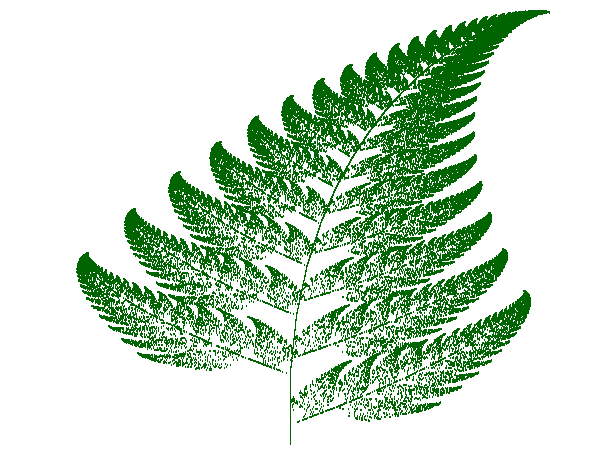Algorithmic Elegance: Fractal Symphonies in R
Persuing M.Sc.Mathematics with Data Science, Institute of Mathematics & Application, Bhubaneswar, Odisha
Unraveling Nature’s Code
Unveiling Chaotic Elegance
At first, it will look pretty random but soon a familiar form emerges. The trajectories that began on the edges seem to speed off in random directions. But all those that began within a certain space end up in the attractor. It might seem like their starting positions no longer matter, but once they reach the attractor, their trajectories diverge, each following its path indefinitely, and they never cross. So, the small differences in their start positions lead to increasingly different futures.


This is the poster child of chaos theory and is sometimes almost synonymous with the butterfly effect or the field of chaos theory itself. It even looks like a butterfly.
Trajectories are just curves, so they should be 1-dimensional. But how come no matter how much you zoom in on this attractor, you can always find more and more trajectories everywhere?
This is the reason that this attractor is said to have a non-integer dimension. It’s made up of infinitely long curves in a finite space, which are so detailed that they start to partially fill up a higher dimension. It’s not 1 dimensional, 2 dimensional, or 3 dimensional - it’s dimension is somewhere in between. As a result of this non-integer dimension and detail of arbitrarily small scales, the set of points in the Lorenz attractor is a fractal space, and that’s why it’s a strange attractor.
A strange attractor has a fractal structure. A fractal structure is a geometric shape that has a fractional dimension.
Bridging Science and Aesthetics
Chaos, present in everything from a drop of water to the galaxies in our universe, has long fascinated people from cultures around the world. The natural disorder present in the branches of trees, lightning, and coastlines, to name a few examples, may seem to be completely chaotic. However, self-similarity within these phenomena is much more organized than it appears. Repeating patterns in many natural objects and processes are known as fractals – figures that show self-similarity at different levels.


The Fascinating World of Natural Fractals
Fractals are patterns formed from what is known as chaotic equations. They exhibit self-similar patterns of complexity regardless of magnification. When divided into parts, they produce a nearly identical, reduced-sized copy of the whole. With fractals, infinite complexity is formed with relatively simple equations. By iterating or repeating these equations many times, random outputs create amazing patterns that are unique yet recognizable. However, most fractals in nature do not repeat forever. The repetition eventually breaks down in natural patterns, and they cease to be fractals. In many cases, fractal patterns are the most efficient way to deliver nutrient-harvested sunlight or form support structures for plants or animals.


Towards the Realm of Fractal


Self-Similarity & Fractals
Self-similarity, a fascinating property observed in nature, forms the cornerstone of Benoit Mandelbrot’s pioneering work in fractal geometry. This concept entails objects appearing identical regardless of the scale at which they are observed, offering profound insights into the intricate patterns found in natural phenomena. When looking around nature, you might have noticed intricate plants like these:


Initially, these appear like highly complex shapes – but when you look closer, you might notice that they both follow a relatively simple pattern: all the individual parts of the plants look the same as the entire plant, just smaller. The same pattern is repeated over and over again, at smaller scales. In mathematics, we call this property self-similarity, and shapes that have it are called fractals.
Navigating Uncertainty
Set-up of The Game
| A number appears in the dice | Where the particle moves |
|---|---|
| 1 | (0.8x+0.1,0.8y+0.04) |
| 2 | (0.6𝑥+0.19,0.6𝑦+0.5) |
| 3 | (0.466(𝑥−𝑦)+0.266,0.466(𝑥+𝑦)+0.067) |
| 4 | (0.466(𝑥+𝑦)+0.456,0.466(y−x)+0.434) |
Assume a particle is located at the origin, i.e., at (0,0) of a two-dimensional Euclidean plane. Consider a die with four sides denoted by the integers 1,2,3,4. The particle moves on the plane according to rules as shown in Table 1: Initially, the particle is at (0,0); now, imagine 2 shows up after throwing the die. From the rules described in the table, the particle will move to (0.6𝑥+0.19,0.6𝑦+0.5) where (𝑥,𝑦) is its current coordinate. For us, (𝑥,𝑦)=(0,0)=𝑋0 the initial position of the particle, and since 2 has appeared, the next position or co-ordinate of the particle is the initial position of the particle, and since 2 has appeared, the next position or co-ordinate of the particle is,
(0.6×0+0.19,0.6×0+0.5)=(0.19,0.5)=X1
We mark the point (0.19,0.5) with a pen. We throw the die again, and depending on the number, and the particle moves to a different point from (0.19,0.5). If we repeat these steps for, say, 20,000 times (Of course, that requires the help of a computer) and mark those points on the plane, we generate a picture.
The Output

The Mystery
We were engaged in the exploration of random phenomena, and the intrigue surrounding these random occurrences lies in the game we were actively participating in. The revelation of this interesting aspect becomes apparent when we alter the system of equations in a specific manner.
| A number appears in the dice | Where the particle moves |
|---|---|
| 1 | (0,0.16y) |
| 2 | (0.85x−0.04y,−0.04x+0.85y+1.6) |
| 3 | (0.2x−0.26y,0.23x+0.22y+1.6) |
| 4 | (−0.15x+0.28y,0.26x+0.24y+0.44) |
pBarnsleyFern <- function(fn, n, clr, ttl, psz=600) {
cat(" *** START:", date(), "n=", n, "clr=", clr, "psz=", psz, "\n");
cat(" *** File name -", fn, "\n");
pf = paste0(fn,".png"); # pf - plot file name
A1 <- matrix(c(0,0,0,0.16,0.85,-0.04,0.04,0.85,0.2,0.23,-0.26,0.22,-0.15,0.26,0.28,0.24), ncol=4, nrow=4, byrow=TRUE);
A2 <- matrix(c(0,0,0,1.6,0,1.6,0,0.44), ncol=2, nrow=4, byrow=TRUE);
P <- c(.01,.85,.07,.07);
# Creating matrices M1 and M2.
M1=vector("list", 4); M2 = vector("list", 4);
for (i in 1:4) {
M1[[i]] <- matrix(c(A1[i,1:4]), nrow=2);
M2[[i]] <- matrix(c(A2[i, 1:2]), nrow=2);
}
x <- numeric(n); y <- numeric(n);
x[1] <- y[1] <- 0;
for (i in 1:(n-1)) {
k <- sample(1:4, prob=P, size=1);
M <- as.matrix(M1[[k]]);
z <- M%*%c(x[i],y[i]) + M2[[k]];
x[i+1] <- z[1]; y[i+1] <- z[2];
}
plot(x, y, main=ttl, axes=FALSE, xlab="", ylab="", col=clr, cex=0.1);
# Writing png-file
dev.copy(png, filename=pf,width=psz,height=psz);
# Cleaning
dev.off(); graphics.off();
cat(" *** END:",date(),"\n");
}
## Executing:
pBarnsleyFern("BarnsleyFernR", 100000, "dark green", "Barnsley Fern Fractal", psz=600)
library(grid)
A=vector('list',4)
A[[1]]=matrix(c(0,0,0,0.18),nrow=2)
A[[2]]=matrix(c(0.85,-0.04,0.04,0.85),nrow=2)
A[[3]]=matrix(c(0.2,0.23,-0.26,0.22),nrow=2)
A[[4]]=matrix(c(-0.15,0.36,0.28,0.24),nrow=2)
b=vector('list',4)
b[[1]]=matrix(c(0,0))
b[[2]]=matrix(c(0,1.6))
b[[3]]=matrix(c(0,1.6))
b[[4]]=matrix(c(0,0.54))
n <- 500000
x <- numeric(n)
y <- numeric(n)
x[1] <- y[1] <- 0
for (i in 1:(n-1)) {
trans <- sample(1:4, prob=c(.02, .9, .09, .08), size=1)
xy <- A[[trans]]%*%c(x[i],y[i]) + b[[trans]]
x[i+1] <- xy[1]
y[i+1] <- xy[2]
}
plot(y,x,col= 'darkgreen',cex=0.1)
The Artistry of Growth
Canopy Chronicles


From Doodling to Natural Phenomena

Investigation into Iterative Drawing Algorithms
We’re investigating the implementation and application of iterative drawing algorithms, particularly focusing on recursive tree generation. The primary objective is to explore the rationale behind the development of code segments aimed at creating intricate tree-like structures through iterative processes.
At the Beginning of the Iteration






After Iteration 10


Nature’s Artistry


Pythagoras Tree




Geometric Fractals
Sierpinski Triangle
Introduction
The Sierpinski triangle, named after the Polish mathematician Wacław Sierpiński, is one of the most iconic geometric fractals. This fractal is formed through a recursive process of subdividing a triangle into smaller triangles and removing the central triangle at each iteration. The resulting pattern is characterized by intricate triangular shapes nested within one another, demonstrating the mesmerizing beauty of self-similarity.

Origin
At its core, the Sierpinski triangle is a self-similar fractal, comprised of an equilateral triangle with smaller equilateral triangles recursively removed from its remaining area. This recursive removal process creates a fascinating visual effect, wherein the final shape consists of three identical copies of itself, each composed of even smaller copies of the entire triangle. This property allows for an endless zooming-in process, with patterns and shapes continuously repeating at ever-smaller scales.

Construction
The construction of the Sierpinski triangle follows a systematic progression. Starting with a simple equilateral triangle, the first step involves removing the middle triangle, leaving behind three black triangles surrounding a central white triangle (iteration 1). This process is then repeated at a smaller scale, removing the middle third of each of the three remaining triangles, resulting in the second iteration with nine smaller black triangles. The number of smallest triangles triples with each iteration, yielding 27 triangles in the third iteration and 81 triangles in the fourth iteration. This tripling pattern continues indefinitely, and the number of triangles, denoted as T, can be expressed as T=3n, where n represents the iteration level.
Sierpinski Carpet
Introduction
The Sierpinski Carpet, a captivating fractal pattern, was introduced by the Polish mathematician Wacław Sierpiński in 1916. This fractal, also known as the Sierpiński square or the Sierpiński sponge in three dimensions, exhibits intricate self-similarity and has captured the imagination of mathematicians, artists, and enthusiasts alike.
Origin
Wacław Sierpiński conceived the Sierpinski Carpet as a natural extension of his work on fractals, following his exploration of the Sierpinski triangle. The carpet’s inception marked a significant advancement in the understanding of fractal geometry and its applications across diverse fields.
Construction
The construction of the Sierpinski Carpet follows a straightforward iterative process that yields strikingly complex results. Begin with a square divided into nine equal smaller squares arranged in a 3x3 grid. Remove the central square, leaving behind eight smaller squares. Repeat this process for each remaining square indefinitely. Through this recursive procedure, the Sierpinski Carpet emerges—a geometric wonder characterized by an infinitely repeating pattern of voids within a larger square.
The construction of the Sierpinski Carpet exemplifies the recursive nature of fractals, where simple rules repeated over and over again produce intricate and mesmerizing patterns. Despite its seemingly straightforward construction, the Sierpinski Carpet possesses remarkable properties, such as infinite perimeter and zero area, challenging conventional notions of geometry and dimensionality.


The Koch Snowflake
Introduction
In the realm of mathematical beauty, few patterns captivate the imagination quite like the Koch snowflake. This intricate fractal, named after the Swedish mathematician Helge von Koch, showcases the mesmerizing synergy between simplicity and complexity found in nature’s design. As we embark on our journey to unravel the secrets of this geometric wonder, we delve into its origins, construction, and significance in both mathematics and the natural world.
Origins
The story of the Koch snowflake begins in the early 20th century when Helge von Koch introduced the concept as a means to explore the notion of infinite perimeter within a finite area. In 1904, Koch presented his groundbreaking paper, “On a Continuous Curve Without Tangents, Constructible from Elementary Geometry,” unveiling this remarkable fractal.
Construction
At its core, the Koch snowflake emerges from a deceptively simple iterative process. Start with an equilateral triangle, then replace the middle third of each line segment with two segments of equal length, forming a smaller equilateral triangle. Repeat this process infinitely for each remaining line segment, and behold—the Koch snowflake emerges in all its intricate glory. Despite its seemingly straightforward construction, the Koch snowflake possesses an infinite perimeter, yet encloses a finite area—an astounding paradox that showcases the beauty of fractal geometry.


Conclusion
Geometric fractals not only captivate the imagination but also have practical applications in various fields, including computer graphics, image compression, and even the study of natural phenomena like coastlines and clouds. By unraveling the secrets of these fascinating structures, scientists and mathematicians continue to uncover new insights into the underlying principles that govern our universe.
In the realm of science, the study of geometric fractals serves as a reminder of the inherent order and complexity that permeates the natural world. From the intricate patterns of snowflakes to the sprawling landscapes of coastlines, fractals offer a window into the hidden symmetries and patterns that shape our reality. As we delve deeper into the mysteries of geometric fractals, we embark on a journey of discovery that unveils the wondrous beauty of nature’s infinite complexity.
Footnotes
See Also
Feel Free to Reach out
My Website: https://abhirup-moitra-mathstat.netlify.app/
E-mail: amityabhirup@gmail.com
LinkedIn: https://www.linkedin.com/in/abhirup-moitra-7a66731a6/
My Community: The Era of Chaos
Thank You
